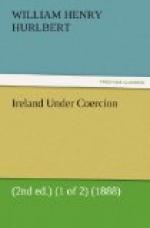[16] This “townland” is a curious use of a Saxon term to describe a Celtic fact. The territory of an Irish sept seems to have been divided up into “townlands,” each townland consisting of four, or in some cases six, groups of holdings, occupied by as many families of the “sept.” The chief of the “sept” divided up each “townland” periodically among these groups, while the common fields were cut up among the families as they increased and multiplied according to the system—against which Lord George Hill battled at Gweedore—known as “rimdale” or “rundeal,” from the Celtic, “ruindioll,” a “partition” or “man’s share.” This is quite unlike the Russian “mir” or collective village, and not more like the South Slav “zadruga” which makes each family a community, the land belonging to all, as, according to M. Eugene Simon, it does in China. But it is as inconsistent with Henry George’s State ownership of the land or the rents as either of those systems.
[17] From a question just asked (July 12) in the House of Commons, and answered by the Postmaster-General, I gather that this “local question” has been further complicated by the removal of Mr. Sweeney, the sub-postmaster, under an official regulation.
[18] The incident occurred in Clare. See p. 45.
[19] Or they may date back to the Parliament of Grattan, who wrote to Mr. Guinness that he regarded the brewery of Ireland as “the actual nurse of the people, and entitled to every encouragement, favour, and exemption.”
[20] This refers, I am told, to the murder, in open daylight, in 1881, of an old man, Linnane, who acted as a “caretaker” for Mrs. Moroney. It should gratify Father White to know that, as I am now informed (May 21, 1888), a clue has just been found to the assassins, who appear to have received the same price for doing their work that was paid the murderers of Fitzmaurice.
[21] Mrs. Moroney, so often referred to here, is the widow of a gentleman formerly High Sheriff and Deputy-Lieutenant for the County Clare, who died in 1870. She lives at Milton House, and has fought the local League steadily and successfully.



